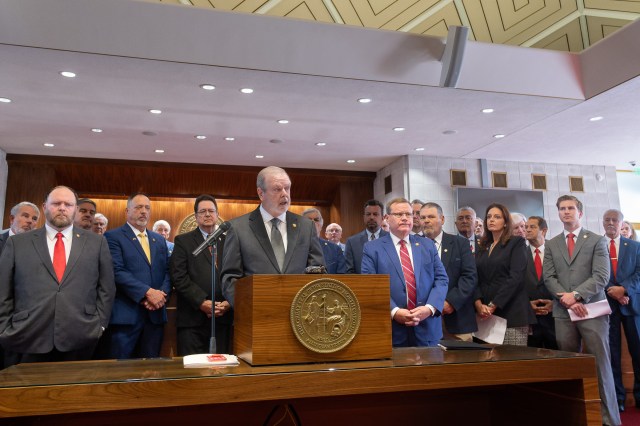Stay ahead of the curve as a political insider with deep policy analysis, daily briefings and policy-shaping tools.
Request a DemoSector report highlights North Carolina tech investments

Jim Weaver, state chief information officer and secretary of North Carolina’s Department of Information Technology, speaks with legislators after a meeting of the Joint Legislative Oversight Committee on Information Technology on April 18, 2024. (Credit: Clifton Dowell)
By Matthew Sasser, State Affairs Pro
Last fall, the state’s top technology officer had a question for a classroom of Richmond County high school students: “You know there’s over 21,000 jobs today in North Carolina alone available for cybersecurity?”
Jim Weaver, the state’s Department of Information Technology secretary and state chief information officer, had just dropped off a carload of school supplies and equipment to the computer science students in one of North Carolina’s more rural counties.
“For you to be successful, no matter what career field you end up choosing, there’s going to be a component of information technology that you’re going to have to learn how to use and consume,” Weaver said. “Please, take these classes seriously that you’re in. Get your credit, do the best you can. It is building you for success in the future.”
Based on data from the North Carolina State of Technology Industry Report shared with legislators and sector leaders on Wednesday, there may not be a better state for those words to have been spoken in.
No county left behind
Amidst the hectic final day of the short session on Thursday, Senate Bill 743 didn’t receive much fanfare.
“This is a fantastic bill,” Rep. Jake Johnson, R-Polk, said. “It will allow for $1.5 billion to come down from the federal government and all counties can participate in the CAB [Completing Access to Broadband] program.”
Days before, it had been stressed in a committee meeting that it was necessary to get rid of a county match requirement preventing 65 counties, who did not initially commit any local funding toward this endeavor, from securing any money.
“If we don’t start projects or award projects until September or later, then we’re going to end up with three months, or fewer months, to complete $350 million worth of projects and not have room for any providers to seek extensions, so we’re cutting it close there,” Nate Denny, the department’s deputy secretary for broadband and digital equity, stressed in a House committee last week.

It is crucial for the Senate to take up SB 743 during one of the reconvenings built into the session’s adjournment resolution, Johnson said during a recess during the final hour of Thursday’s House session. Failure to do so would leave most North Carolina counties out of federal CAB grant funding, he added.
Johnson said he has been in conversation with Sen. Bill Rabon, R-Brunswick, who as chairman of the Senate Rules Committee largely directs the flow of legislation in that chamber.
Combined with American Rescue Plan plan funding, North Carolina has made major advances in securing broadband access and creating a future that is hospitable to a tech-centered workforce. NCDIT will launch BEAD-funded programs in January of 2025.
“Every company is a tech company whether they know it or not,” Johnson said.
Punching above its weight
Brian Gregory, vice president of state government affairs for Charter Communications and chair of the North Carolina Tech Board, said North Carolina is the envy of other states when he attends national conferences.
“The model that we have done as a state here [in] a bipartisan manner to set up broadband grant programs is top-notch,” Gregory said at the opening of the House Appropriations and Information Technology Committee on Wednesday.
The NCSTIR report is an “environmental scan” of how North Carolina stacks up against other states in various technology metrics, according to Brooks Raiford, president and CEO of the North Carolina Technology Association.
Over 50,000 tech jobs were added to the North Carolina economy between 2017 and 2022. The state has 11 counties where tech industry jobs account for more than 6% of total employment. Among tech jobs available in the state, only 55% require some postsecondary education.
North Carolina remains at the top for female tech employees, with women accounting for 37.1% of the industry’s workforce, trailing only the District of Columbia. Just over 50% of in-state STEM program completers remain in North Carolina, Raiford said, adding that the state is not subject to a “brain drain.”
The Raleigh-Cary and Durham-Chapel Hill metro areas are consistently among the most coveted and innovative areas for technology in nationwide rankings, Raiford added. “Independently, [Raleigh and Durham] rank in the top 10. Imagine if they were one.”
Raiford highlighted that Wilmington “punches above its weight” and has consistently been named the world’s No. 1 entrepreneurship ecosystem with a population under 300,000.
Weaver, the state’s technology chief, said it’s a “culture change” that digital government services have been identified as one of the top priorities of the National Association of State Chief Information Officers.
“This is not necessarily a technology problem,” Weaver said. “We have to start thinking about ‘How do we service North Carolinians differently?’ … I think local government is well ahead of us on this path.”

This year marks the first time artificial intelligence appears on the association’s environmental scan list. Weaver said many good and powerful uses of AI can also be dangerous, especially around data. He added that an AI framework document aims to address the issue.
“For generative AI to be successful … it’s about the data,” Weaver said. “Generative AI by itself cannot do anything. It needs data, and we are the keepers of that data.”
Weaver said his department is taking a risk-based approach to everything involving AI: A work group has been assembled with various business and information technology leaders with the primary goal of keeping North Carolinians’ data safe.
With the rise of generative AI comes power consumption concerns. The data centers run at the state level cannot generate the power requirements that new technology requires, Weaver said. Water cooling systems are now being introduced in high-consumption data centers to handle the wattage.
A dashboard is available for the public to see current broadband projects and funding status, as well as anticipated completion dates, at ncbroadband.gov.
For questions or comments, or to pass along story ideas, please write to Matthew Sasser at [email protected] or contact the NC Insider at [email protected] or @StateAffairsNC
Know the most important news affecting North-carolina
Get our free weekly newsletter that covers government, policy and politics that impact your everyday life—in 5 minutes or less.
VIDEO: Speaker-designate announces 2025 GOP House leadership positions
NC House Speaker-designate Rep. Destin Hall discusses GOP leadership positions in the House for the 2025-26 Biennium of the North Carolina General Assembly. Know the most important news affecting North-carolina Get our free weekly newsletter that covers government, policy and politics that impact your everyday life—in 5 minutes or less. Sign Up
‘1,000-year events’ keep happening. How can North Carolina better prepare?
Hurricane Helene is the deadliest storm in North Carolina history. The overall impact of damage from Helene will likely exceed $53 billion, an initial assessment conducted by the Office of State Budget and Management suggests. The death toll reached over 100 reported deaths in the state on Oct. 30. More than 100,000 homes are estimated …
Josh Stein elected governor, defeating Mark Robinson in heated, historic race
RALEIGH — Voters in North Carolina selected Democrat Josh Stein to be the state’s next governor on Tuesday, bringing to a close a campaign that drew the attention of the country, often for the wrong reasons. With 2,288 of 2,658 precincts reporting, Stein had garnered 55% of the vote; his Republican opponent, Lt. Gov. Mark …
Election Day 2024: State Affairs brings you the fair, transparent, nonpartisan coverage you deserve
Election Day is here and State Affairs stands ready to bring you the kind of election coverage you deserve — fair, transparent and rooted in a commitment to nonpartisanship. Across the states, voters are casting their ballots, deciding on leaders and policies that will shape our communities and futures. And as the results come in, …




